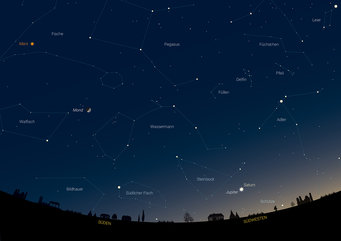Jupiter Meets Saturn - very close conjunction on 21 December 2020
Jupiter and Saturn are the two biggest planets in the solar system. In space, they are separated by 660 million kilometers on average. Looking from Earth though, the two gas giants can come very close when the faster Jupiter overtakes the more distant Saturn on its orbit. This happens about every 20 years. This year's overtaking maneuver is special: For the naked eye, the two planets will likely merge into a single bright object.

A conjunction is a meeting of celestial bodies like the Moon or the planets in the sky. Because they move at different speeds on the celestial sphere, meetings of two or even more participants occur several times per year. A conjunction of Jupiter and Saturn is rare, it happens only every 20 years and is called a "great conjunction". The last time the two approached each other was on 31 May 2000, but they were too close to the Sun to be visible in the night sky back then. On 24 July 1981, the observing conditions were more favorable, with Jupiter and Saturn appearing in the late evening sky, but were still more than two apparent diameters of the full Moon apart.
This year, Jupiter and Saturn can easily be observed in the evening sky in the twilight, and they are coming as close as one-fifth of the diameter of the full Moon (6 arcminutes). A similarly close great conjunction will not occur again until March 15, 2080, but when it's already bright at dawn. In short, the conjunction of Jupiter and Saturn on 21 December 2020, which happens to coincide with winter solstice, is the best the universe has to offer for a long time.

Currently, Jupiter and Saturn can be found in the southwestern evening sky, getting closer and closer to each other. On 17 December, the waxing Moon will pass them. No telescope is needed to observe the meetup of the two planets: Jupiter is brighter than the brightest stars and Saturn only slightly fainter, both can be recognized at first sight. The brighter Jupiter will on the lower left of the fainter ring planet. On 21 December, the day of closest approach, it will be a challenge to see them separately with the naked eye. After that, the distance between the two increases again. But even on 20 or 22 December, the distance is only slightly bigger.
With binoculars, you can see several of Jupiter's four Galilean moons. For Saturn's ring, however, a telescope with at least a magnification of 30x is needed; a good spotting scope for nature observation already will do.

